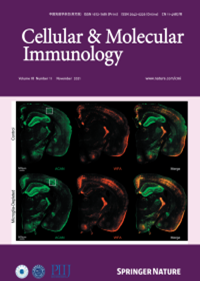Inflammation-triggered Gli1+ stem cells engage with extracellular vesicles to prime aberrant neutrophils to exacerbate periodontal immunopathology
IF 19.8
1区 医学
Q1 IMMUNOLOGY
引用次数: 0
Abstract
Periodontitis is a prevalent and progressive detrimental disease characterized by chronic inflammation, and the immunopathological mechanisms are not yet fully understood. Mesenchymal stem cells (MSCs) play crucial roles as immunoregulators and maintain tissue homeostasis and regeneration, but their in vivo function in immunopathology and periodontal tissue deterioration is still unclear. Here, we utilized multiple transgenic mouse models to specifically mark, ablate and modulate Gli1+ cells, a critical and representative subset of MSCs in the periodontium, to explore their specific role in periodontal immunopathology. We revealed that Gli1+ cells, upon challenge with an inflammatory microenvironment, significantly induce rapid trafficking and aberrant activation of neutrophils, thus exacerbating alveolar bone destruction. Mechanistically, extracellular vesicles (EVs) released by Gli1+ cells act as crucial immune regulators in periodontal tissue, mediating the recruitment and activation of neutrophils through increased neutrophil generation of reactive oxygen species and stimulation of nuclear factor kappa-B signaling. Furthermore, we discovered that CXC motif chemokine ligand 1 (CXCL1) is exposed on the surface of EVs derived from inflammation-challenged Gli1+ cells to prime aberrant neutrophils via the CXCL1-CXC motif chemokine receptor 2 (CXCR2) axis. Importantly, specific inhibition of EV release from Gli1+ cells or pharmacological therapy with GANT61 ameliorates periodontal inflammation and alveolar bone loss. Collectively, our findings identify previously unrecognized roles of Gli1+ cells in orchestrating infiltration and promoting aberrant activation of neutrophils under inflammation, which provides pathological insights and potential therapeutic targets for periodontitis.

炎症引发的Gli1+干细胞与细胞外囊泡结合,引发异常中性粒细胞,加剧牙周免疫病理。
牙周炎是一种以慢性炎症为特征的普遍进行性疾病,其免疫病理机制尚不完全清楚。间充质干细胞(Mesenchymal stem cells, MSCs)在免疫调节和维持组织稳态和再生方面发挥着至关重要的作用,但其在体内免疫病理和牙周组织恶化中的功能尚不清楚。在这里,我们利用多个转基因小鼠模型特异性标记,消融和调节Gli1+细胞,牙周组织中MSCs的一个关键和代表性亚群,以探索其在牙周免疫病理中的特定作用。我们发现,Gli1+细胞在受到炎症微环境的挑战时,显著诱导中性粒细胞的快速运输和异常激活,从而加剧了牙槽骨的破坏。在机制上,Gli1+细胞释放的细胞外囊泡(EVs)在牙周组织中充当重要的免疫调节剂,通过增加中性粒细胞生成活性氧和刺激核因子κ b信号传导介导中性粒细胞的募集和激活。此外,我们发现CXC基序趋化因子配体1 (CXCL1)通过CXCL1-CXC基序趋化因子受体2 (CXCR2)轴暴露在炎症挑战的Gli1+细胞衍生的EVs表面,以引发异常中性粒细胞。重要的是,特异性抑制Gli1+细胞的EV释放或GANT61药物治疗可改善牙周炎症和牙槽骨丢失。总的来说,我们的研究结果确定了Gli1+细胞在炎症下协调浸润和促进中性粒细胞异常活化中的作用,这为牙周炎提供了病理见解和潜在的治疗靶点。
本文章由计算机程序翻译,如有差异,请以英文原文为准。
求助全文
约1分钟内获得全文
求助全文
来源期刊
CiteScore
31.20
自引率
1.20%
发文量
903
审稿时长
1 months
期刊介绍:
Cellular & Molecular Immunology, a monthly journal from the Chinese Society of Immunology and the University of Science and Technology of China, serves as a comprehensive platform covering both basic immunology research and clinical applications. The journal publishes a variety of article types, including Articles, Review Articles, Mini Reviews, and Short Communications, focusing on diverse aspects of cellular and molecular immunology.

 求助内容:
求助内容: 应助结果提醒方式:
应助结果提醒方式:


